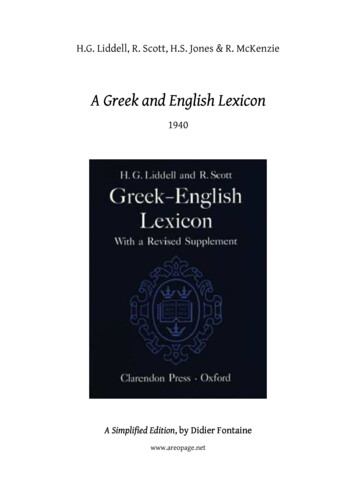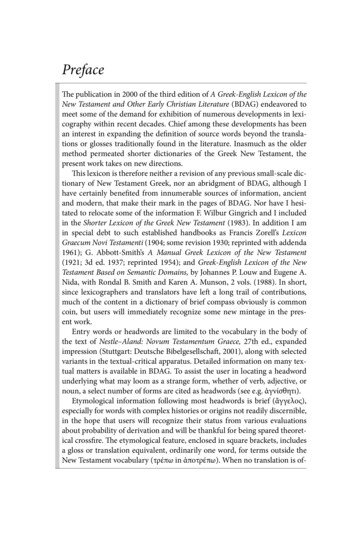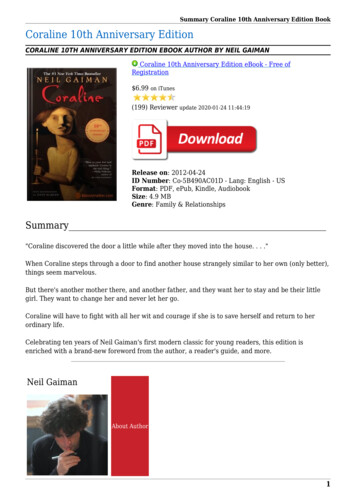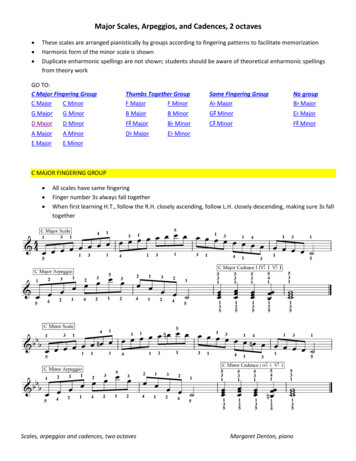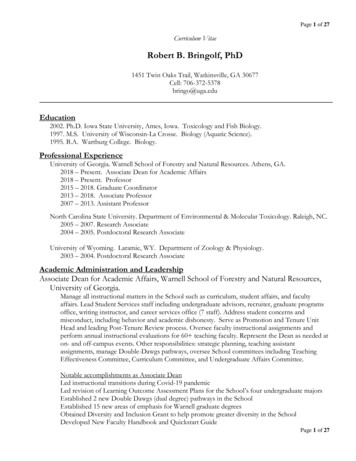Transcription
EnglishSpellingsA LexiconDave Philpot, John Walker & Susan Casewww.sounds‐write.co.uk
We would like to express our thanks to Mary Gladstone, Sarah Horner, Garry Phillipson andDick Schutz for reading draft versions of this document and giving us helpful and encouragingcomments.First published: February 2007This edition: April 2011 Sounds Write Ltdi
Table of ContentsPART 1Introduction - English Spelling: the myth of its irregularity .iiiA discussion and analysis of English spelling . . .1Appendix A. Schwas – the weak vowel sounds of EnglishAppendix B. The notion of 'silent letters' . .21 .23Appendix C. Elision: The tendency for native English speakers to shorten andabbreviate words . .25Appendix D. Patterns to be found in consonant spellings . .26Appendix E. The phoneme 'r ' . .28PART 2The lexicon . . . .29. . . .29Section 2: The vowels . . .58Section 3: All spellings . . .86Section 1: The consonants Sounds Write Ltdii
English spelling: the myth of its irregularityIntroductionSpelling in English has long been thought an intractable problem. Over four hundredand fifty years ago John Hart was writing to deplore the difficulties of learning to readand to spell. In both of his books1, The Opening of the Unreasonable Writing of OurEnglish Toung and A Methode or comfortable beginning for all unlearned, wherebythey may be taught to read English, in a very little time, with pleasure, we get fromthe titles an idea about Hart's thinking on the matter. In the second book, Hartexpounds his belief that orthography or spelling should represent sounds and thengoes on to identify the principal problems with the spelling system. To begin with, heinforms us that letter names are an obstacle to learning to read and spell! The letters,as he put it, 'are misnamed much from their offices and natures, whereby thedesirous are much the more hindered from learning to reade, though they were neverso willing' 2. The second problem was that letters often represent more than onesound and that sounds are frequently spelled in different ways. Hart's solution, likemany of those who followed him up to present times, was spelling reform - analternative we firmly reject3.Two hundred years after Hart Dr Samuel Johnson wrestled with precisely the samedilemmas. The starting point for his dictionary was one 'by which the pronunciation ofour language may be fixed'4, a chimera pursued by many before and after Johnson.However, once started on his famous dictionary, Johnson quickly realised theimpossibility of achieving fixity in the language and moved to the position, taken up inthe Preface to his dictionary, of mocking the 'folly, vanity and affectation' of anyoneimagining they could 'embalm' the language. 'Dictionaries,' he added, 'are likewatches. The worst is better than none, and the best cannot be expected to go quitetrue.'51The Opening of the Unreasonable Writing of Our English Toung (1551), An orthographie, conteyningthe due order and reason, howe to write or paint thimmage of mannes voice, most like to life or nature(1569), and A Methode or comfortable beginning for all vnlearned, whereby they may bee taught toread English, in a very little time, with pleasure (1570)2Hart, J., (1570), A Methode or comfortable beginning for all vnlearned, whereby they may bee taughtto read English, in a very little time, with pleasure3The problem with spelling reform is that it would have to link the spelling of English to one of theaccents of English. It would also mean that all previous writings would have to be transcribed into thenew script to make it accessible to learners of the new method.4Johnson, S, (1755) Dictionary of the English Language.5Quoted by Kermode, F., in 'Lives of Johnson' in The New York Review of Books, Vol LIII, Number II,22/06/2006. Sounds Write Ltdiii
Although Johnson complained about the great deal of uncertainty in this domain, asDavid Crystal argues in his Stories of English6, 'orthography had received a greatdeal of attention prior to the writing of Johnson's dictionary' and, as can be seen fromhow easy it is to read the titles of Hart's three books, 'three hundred years of steadystandardisation in spelling had resulted inenormous consensus By Johnson's time there was no real evidence of serious'uncertainty' in orthography.7'Nevertheless, consensus there might be, but the manner in which English speechsounds relate to their spellings appears for many still shrouded in mystery. Thisbooklet was written to demonstrate that, contrary to popular belief, the relationshipbetween the two is much more consistent than is generally believed and,furthermore, that reading and spelling are but two sides of the same coin that can, ifthe teaching is appropriate, be taught accurately and 'with pleasure’, as Hart claimedall those years ago.How do these long-standing conundrums about English spellingimpinge upon us today?There is a widely held belief that one of the main reasons underlying the high levelsof illiteracy in the English speaking world is the irregularity, or irrationality, of Englishspelling. We intend to demonstrate in this booklet that this belief is completelyunfounded. We confidently assert the proposition that, English spelling is highlyregular.Why does it matter that spelling is regular?It matters because the ways in which children are shown how to learn to read andspell in our schools are often underpinned by erroneous beliefs about spelling. Thesefalse beliefs have resulted in our common teaching practices being riddled withpedagogic errors resulting in hundreds of thousands of effectively illiterate studentsleaving our schools each year as a direct consequence of the failings inherent withinthe literacy tuition they have encountered.If the English spelling system were irregular this would point to the necessity of awhole language approach in which complete words would need to be6Crystal, D, (2005), Stories of English, p.393.7Crystal, D, (2005), Ibid., p393. Sounds Write Ltdiv
photographically stored in visual memory as though they were symbols akin topictograms. On the other hand, if English is spelled in a regular manner, as wecontend, then it is the phonic alphabet code that needs to be unlocked and childrenmust be taught literacy by an accurate and thoroughly consistent approach. And, asDiane McGuinness has repeatedly pointed out,'Phonemes are the basis for the code, and the letters are the code' 8.As already stated, in this booklet the regularity of English spelling will bedemonstrated beyond all reasonable doubt, whilst accepting that, for varioushistorical reasons, English spelling is far more complex than necessary for thepurpose of recording our speech and thoughts.Within this short article English text is carefully scrutinised to unlock the key issuesunderpinning the current state of English spelling, culminating in a lexicon ofexamples covering all the main alphabetic encodings of English speech sounds.Although we shall discuss what needs to be done to teach literacy effectively to ALLour children, with the exception of a few special needs pupils who experience severemental and/or sensory handicap, this is not a booklet about teaching methods, butone for directing attention to the reasons why certain types of teaching strategies arenecessary. The actual principles of 'how' to teach literacy effectively we have alreadyaddressed within our literacy tuition programme: Sounds Write9.89McGuinness, D., (2004), Early Reading Instruction, MIT Press, p.13.Case, S, Philpot, D, and Walker, J, (2003) Sounds Write (Teaching Manual). Sounds Write Ltdv
A discussion and analysis of English spellingWriting in English consists of making marks on paper, called letters. It is these lettersthat represent the sounds of our speech written in the same order as they arespoken. Conventionally these are sequenced from left to right across the page withsuccessive lines progressing from the top to the bottom of the page. The Englishlanguage, depending on accent, contains 42 to 45 sounds known as phonemes (thesmallest distinguishable units of speech that we can hear). All of the common coresounds are shown in the table below together with the way in which we shallrepresent them in this book.Table One:The speech sounds of the English herpinpiepottoefortoycowbuncuebookmoonabout1If you are uncertain about this, themost common of the Englishvowels, please see Appendix A,page 21.2The letter x encodes twosounds, pronounced as either'ks' or sitshoptapthinthevanwetbox / examyetzooazure*NV - not voiced**V - voicedThroughout the text speech sounds (phonemes) will be indicated by placing themwithin speech marks and spellings (graphemes) within chevron brackets. So, forexample, the word beach is made up of the following three speech sounds, Sounds Write Ltd1
'b' 'ee' and 'ch', that are represented by the three spellings: b ea & ch .Please note that, although ea in this example is comprised of two letters, itrepresents only one sound as does the following ch . In written English, spellingsmay be composed of one, two, three or four letters as shown by the followingunderlinings: c a t, ch ar t, m igh t and eigh t . Where appropriate these will bereferred to as single-letter, two-letter, three-letter or four-letter spellings. When writingabout the two sounds commonly represented by the spelling oo , to avoidconfusion they will be referred to as either 'book' or 'moon'.Some words of caution before proceeding: If in doubt about the pronunciation of a word, listen to yourself or otherssaying it WITHOUT looking at the way it is written down, otherwise you may findyourself making your speech conform to your interpretation of the spelling;whereas, of course, the spelling should represent your speech! Particular care is recommended when considering the weak vowel sounds(called schwas), which are, in fact, the commonest vowel sounds in English. Itis these that cause the most frequent problems for all of us when trying tospell accurately. (See Appendix A, page 21.) Regional accents are mainly to do with the pronunciation of some of thevowels. So, forexample, in the South-East of England the word lookrhymes with shook, but in the North-West it rhymes with (and is pronouncedas) Luke. Accent issues do not affect the arguments being put forward in thisbooklet, but obviously those with different accents to the ReceivedPronunciation adopted in this document will need to make a few minoradjustments to some of the specific examples quoted. In the same way,teachers who are teaching real (ie linguistic) phonics need to adjust someword groupings according to the pronunciations of their pupils.In Table 1 attention was drawn to the sounds of English speech. Two specificquestions now need to be addressed: what are the spellings (graphemes) used torepresent English speech sounds; and what makes a spelling regular?What are the spellings used to represent our speech sounds?The alphabetic writing system is a method of converting spoken language accuratelyinto a visual format (code) from which the original speech can be recovered. Manydifferent systems have been attempted throughout history but, due to (a) thelimitations of human visual memory for abstract symbols and (b) our apparently Sounds Write Ltd2
limitless capacity to generate new words*, only ONE approach has proved viable forthe English language. That is to say, an alphabetic system based on the smallestsound units in speech.(* The full English dictionary is now well on the way to a million entries!)Spoken English contains no real silences other than those generated by a need tointake breath, or to insert a dramatic pause into conversation. It is logical to supposethat every letter in every wordwill either be a spelling in its own right, or else be part of a spelling composed of two,three or four letters. What does this mean in practice? There is universal agreementthat the word cat is composed of the three sounds 'k' 'a' 't', and that these arerepresented by the three spellings c a t . However, analysis of a wordsuch as know that is spelled in a slightly more complicated fashion can causeconfusion. Traditional 'phonic' approaches tend to look at this word as: silent k n ow , with the k representing nothing, the n representing the sound 'n' and the ow representing the sound 'oe’. This iscompletely irrational. There are only two rational possibilities:(a) both k and w are silent, with the n and o respectivelyrepresenting the 'n' and 'oe' sounds; or(b) kn and ow are both two-letter spellings respectively representing the 'n'and 'oe' sounds.Clearly option (b) would be the correct choice because, if letters and combinations ofletters represent the sounds of speech, it does not make much sense to say thereare silent letters. For many readers, the example kn will appear to be a new andunusual two-letter spelling of the sound ' n'. However, this is no more unusual thanpairing the letters s and h to arrive at sh as a two-letter spelling for thesound 'sh' in the word shop.10 If kn is considered to be a spelling of the sound10A significant contribution to English spelling was formulated by Ken Albrow. His book The EnglishWriting System was part of the project Linguistics and English Teaching in the 1970s. Albrow's aimwas to provide a description of the English writing system for teachers based on the British functionaltradition in linguistics now associated chiefly with Halliday.Our approach is in fact similar to Albrow's: he designated the one sound to one letter correspondencesas 'simple', and the combinations of one sound to more than one letter as 'complex'. We agree withVivian Cook's encapsulation: 'All the letters in the written word are either orthographic symbols in theirown right or form part of larger orthographic symbols. Nothing is left over that can be called a "silent"letter. Albrow's approach abolishes silent letters by making them part of the orthographic symbolscontaining more than one letter.'Cook, V., (2004), The English Writing System, Arnold, London.For a fuller discussion of this point see also McGuinness, D., (2004), Ibid., pp53-59. Sounds Write Ltd3
'n', how does it work in practice? Dictionaries that provide a phonic analysis of wordsalongside the spellings, such as knack, kneel, knife, knot, doorknob, etc, makethis point a lot more obvious from the above perspective.What makes the spelling of a speech sound regular?We propose that any spelling is regular if it appears in more than just one word. Spellings thatoccur in only one word we will refer to as being unique, and those that occur in no more thantwo or three words as being unusual. But if a word that contains a unique spelling occurs withhigh frequency within normal speech (therefore also appearing with high frequency in writtentexts) we would also regard that as a regular spelling. However, we only know of one suchexample of a word frequently encountered in both speech and text that contains a uniquespelling of a sound: that word is of, within which the single-letter spelling f represents thesound 'v'. The word of occurs so frequently in spoken and written English that it is not possibleto do other than consider this unique spelling of 'v' to be regular.A spelling such as uy , which represents the sound ' ie', is unusual, but it is clearly aregular spelling in English because we often come across it in the words buy, guy and Guy.However, the one-off four-letter spelling ough , representing the sound 'moon' in the wordthrough we would think of as a unique spelling of the sound 'moon' that we would not referto as being regular.The next step is to begin examining some text to see where the above propositions lead.Obviously if thousands of 'regular spellings of speech sounds' rapidly emerge, this would makethe whole system so complex that it would be impossible to memorise and no-one couldpossibly be a good speller! On page 6, in Figure One, are shown the first six verses of 'TheWalrus and the Carpenter' by Lewis Carroll. This poem has been typed with a space insertedbetween each spelling of a sound in every word, and three spaces between each word. Eachspelling is underlined with the exception of the split spellings of the sounds 'ae' 'ee' ' ie''oe' and 'ue'. These are shown as t a k ē c o p ē and t i m ē , etc. This should make thespelling of each sound totally transparent to all, including readers who may be new to this typeof exercise.As can be seen, this exercise is not difficult to perform. In Tables 2a and 2b on pages 7-8, thefirst for consonants and the second for vowels, we show all the spellings that have been'discovered' in the six verses of 'The Walrus and the Carpenter'. These have been placed intwo columns entitled Regular spelling and Unique spelling? Where examples of a particularspelling have been found in two or more words, they have been placed in the regular spelling Sounds Write Ltd4
column along with the first two examples found in the text. In the other column are shownspellings for which only one example was found in the text. However, to save readerssearching the dictionary for other examples, one has already been placed in the third column.At this stage readers might like to examine the tables 2a and 2b before returning to thediscussion here.Having inspected tables 2a and 2b, we can see that , within this one short text 96 spellingshave been 'discovered' representing 39 of the 45 English speech sounds. The total number ofindividual speech sounds in this passage is 639 and it is quite apparent that most of thespellings found are regularly repeated in other words. Furthermore, where only one example ofa spelling occurs in the passage it has been quite easy to find other examples from memory.In respect of the starting definition of spelling regularity, all 96 spellings found so far are regular,i.e. they occur in more than one word. So, in these six verses of 'The Walrus and theCarpenter' that contain over six hundred speech sounds, not a single one of them has beenrepresented by a unique (non regular) spelling. (Other than the sound 'v' in the word of referred to earlier.) Sounds Write Ltd5
Figure OneThe Walrus and the Carpenter, by Lewis Carroll"Th e t i m ē h a s c o me," th e W a l r u s s ai d,"T o t al k o f m a n y th i ng s:O f sh oe s ― a n d sh i p s ― a n d s ea l i ng w a x―O f c a bb a g e s ― a n d k i ng s ―A n d wh y th e s ea i s b oi l i ng h o t ―A n d wh e th er p i g s h a ve w i ng s.""B u t w ai t a b i t," th e Oy s t er s c r ie d,"B e f ore w e h a ve ou r ch a t;F or s o me o f u s are ou t o f b r ea th,A n d a ll o f u s are f a t!""N o h u rr y!" s ai d th e C ar p e n t er.Th ey th a n k ed h i m m u ch f or th a t."A l oa f o f b r ea d," th e W a l r u s s ai d,"I s wh a t w e ch ie f l y n ee d:P e pp er a n d v i n e g ar b e s i d ē sAre v e r y g oo d i n d ee d ―N ow, i f y ou're r ea d y, Oy s t er s d e ar,W e c a n b e g i n t o f ee d.""B u t n o t o n u s!" th e Oy s t er s c r ie d,T ur n i ng a l i tt le b l ue."A f t er s u ch k i n d n e ss, th a t w oul d b eA d i s m al th i ng t o d o!""Th e n igh t i s f i n ē," th e W a l r u s s ai d."D o y ou a d m i r ē th e v i ew?I t w a s s o k i n d o f y ou t o c o me!A n d y ou are v e r y n i c ē!"Th e C ar p e n t er s ai d n o th i ng b u t"C u t u s a n o th er s l i c ē .I w i sh y ou w ere n o t q u i t ē s o d ea f ―I've h a d t o a s k y ou t w i c ē !""I t s ee m s a sh a m ē," th e W a l r u s s ai d,"T o p l ay th e m s u ch a t r i ck,A f t er w e've b r ough t th e m ou t s o f ar,A n d m a d ē th e m t r o t s o q u i ck!"Th e C ar p e n t er s ai d n o th i ng b u t"Th e b u tt er's s p r ea d t oo th i ck!" Sounds Write Ltd6
Table 2a:#Consonant Sounds found in The Walrus and the CarpenterConsonant ueSpelling?Examplewordboiling but bb cabbagesbubble k comecabbagestalk kings x waxaxle ck trick quick q quite quick'd ' d said and'f ' f before for'g ' g pigs vinegar'h ' h has hot'l ' l Walrussealing al dismalfinal m time many me come some'n ' n many and'p ' p ships pigs pp pepperpuppet'r ' r walrus, cried rr hurrybarrel s walrus said c nice slice ss kindnesskiss t time to tt little butter ed thankedjumped v ve vinegar veryhave I've f of w walrus wax wh why whether u quite quick y i youviewyesreview n thankedink'b' b c 'k ''m ''s ''t ''v ''w ''y ''z ' s has things'sh ' sh shoes ships'ch ' ch chat much'th 'NV th things breath'th 'V th they that'ng ' ng thingssealing Sounds Write Ltd7(not from poem)
Table 2b:Vowel Sounds found in The Walrus and the CarpenterVowelSoundRegularspellingExamplewords'a' a has and a-e shamemade ar a e ea carpenter farafter askcarpenterbread ready e ee y ea we beneed indeedhurry chieflysealing sea'ae ''ar ''e ''ee ''er ''i ' i things ship i kindness I i-e time besides'oe ' o a o of hotwhat wasno so'or ' a walrus all ou u o our outus hurrysome come'ie ''o ''oy ''ow ''u ''book ''moon ' o to do a e er cabbages aschwa Sounds Write Ltdthe beforebutter's pepperAnotherexampleUniquespelling?Exampleword(not from poem) ai ay ey waitplaytheymailMayconvey ai a saidmanyagainany ie chieflyfield ere er ur wereoystersturninghercurl ie y igh criedwhynighttieflyfright oa or ore al ough oy oi ow storewalknoughttoyssoilprow oo oul oo ue oe ou ew couponflew ar u r vinegarwalrusoursugarcactusflour8
What happens if this process is continued through other texts looking for more spellings?Clearly the number of new spellings found will keep increasing for a while and then start to tailoff. We have completed this work and discovered that the 96 spellings already found is justover half of all the common spellings of English. In fact there are fewer than two hundredcommon regular spellings of sounds in English and we have listed them all in Table 3 overleaf.Those who doubt these findings can, if they wish, fairly rapidly carry out a similar exercise oftheir own on any texts they choose and compare their findings with those presented here. Inaddition to looking at 'The Walrus and the Carpenter', we have also looked at the spellings ofthe first five hundred sounds written in each of the three novels Catch 22 by Joseph Heller, TheEnd of the Affair by Graham Greene and Watt by Samuel Beckett. The combined 1500sounds of this exercise are ALL spelled using ONLY the common regular spellings of Englishshown in Table 3. This is complete regularity with no unique spellings at all. We have alsolooked through dozens of other texts ranging from government publications to newspapereditorials, articles and obituaries. Wherever we look, we find a similar high degree of regularity.As yet we have found no easily available text where more than one speech sound in anyconsecutive two hundred is represented by a unique spelling.Beyond the common spellings shown in Table 3 we found only another 54 before starting torun out of words that any normal reader will encounter in a lifetime - without reading some veryspecialist literature indeed, or being an expert crossword aficionado. Interestingly we cameacross very few unique spellings. Most readers will be aware of some common oddities suchas the 'book' in woman, the 'i' in women and the 'o' in yacht (or should it be the 't' inyacht?). But these spellings are really quite unusual. In the first two sections of the lexicon wehave included words containing unique or unusual spellings of a sound, but as you will seethere are not very many of them at all. Why then has English gained its reputation for beingirregularly spelled? We would suggest the following five reasons for discussion:1. The confusion of irregularity with complexity2. The incorporation of foreign words into the English language3. Changes in word pronunciation over time4. Incorrect analysis of English spelling for teaching purposes5. The fundamentally incorrect Whole Language notion that whole words,rather than speech sounds, are the basic units of literacy. Sounds Write Ltd9
Table 3:The Common Spellings of EnglishVowelsConsonantsBat'b'bed blubberDavid grape stain day break'd'dot shudder wriggledvein they eight'f'fat sniff photo laugh'ar'barn calm father laugh'g'got juggle ghost guest rogue'air'air care bear there'h'head whopeg tread friend said many'j'jam gem barge badge suggest'k'cup kit quit back schoolexcessaccount trekking acquireunique'a''ae''e'he see baby treat thief these'ee''er'key ski ceilingstern sir curl work vicar earn'ch''i'pin gypsy English build'ie'icy pie nine sky night buy'm''o'pop want'n''oe''or''l'only toe rose oak own soulchip stitchleg fill bottle panel pluralpupilmap hammer comb hymnsomenote runner knee align done'ng'song drinkThough'p'pen applefor jaw more warn pour roar'r'rip wrist parrot rhymewalk Paul caught boughtwater's'sock kiss city miceloosescentcastle'oy'toy coin'ow'town mouse bough'sh'ship chef tissue suctionspecial passion'u'sun young ton flood't'tent mutter doubt raised'ue'use unit value news neutron'book''moon'schwa'th'NVthink'th'Vthen clothelook should put'v'vat give revving ofhoop do you true suit'w'wit where penguinshoe ruin flew flute'y'adore the custom uponfashion'z'yetzip buzz snooze is cheesepossessNV Sounds Write Ltd10– not voicedV-voiced
The confusion of irregularity with complexityBritish English* contains only 42 – 45 speech sounds depending on accent. A set of only 45symbols (letters) would therefore be both necessary and sufficient to represent them all. Butfor many historical reasons we have ended up with a writing system that uses only 26 letters tohandle all our speech sounds according to the following ideas.i. Symbols called letters are used to represent speech soundsii. Speech sounds may be represented by one, two, three or even four letters as in thewords:hench oo seth erew eigh tiii. Sounds may be represented by more than one spelling as in the words:babys t ai nb r ea kth eyeigh tiv. A spelling may represent more than one sound as shown by the use of the single-letterspelling a in the words:lazyw a t erwasa l ou dThe English spelling system, as we have indicated, is complex. Nevertheless it can bemastered despite its complexity due to the relatively small number of spellings (graphemes)involved. If the problem was one of irregularity, then in all probability no-one could ever learn tospell accurately.In some other countries whose languages are written using very few or no examples of ii, iiiand iv, literacy instruction is straightforward and results in around 98% of children masteringtheir written language over the course of only one academic year. These countries do not havevast numbers of dyslexics supported by professionals and societies claiming that fundamentalneurological problems underly their illiteracy.* British English is the way English is predominantly spoken within the UK, rather than World English which includes anumber of variations from Africa, North America/Canada, Australia/New Zealand, Asia, the Caribbean and thePacific Rim.The incorporation of foreign words into the English languageComplete with abbreviations, the English dictionary is now approaching a million entries. Oneof the reasons for this is the continual adoption and inclusion of words from other languages.Such additions, frequent in the days of empire, are now increasing due to global Sounds Write Ltd11
communications and the influence of the internet. These terms retain the spellings used in theirlanguage of origin: words for example such as Sikh and yacht. This results in a cumulatingsupply of unique/unusual spellings entering the dictionary. Many literacy 'experts' who hold theerroneous belief that English spelling is irregular do so based upon dictionary searches thatreveal these 'foreign' words as though they have equal weight and appear with equalfrequency to other words in our daily speech and reading. This gives a completely false pictureof the regularity of the spelling throughout most English texts.Changes in word pronunciation over timeRalph Waldo Emerson once observed that, 'Language is the archives of history.' Manychanges in pronunciation have occurred during the long history of the evolution of the Englishlanguage that have not resulted in parallel spelling changes. A good example is the wordWednesday, whose spelling does not completely conform with the sounds that are actuallyspoken: 'W ' 'e' 'n' 'z' 'd ' 'ae'. This is because this day of the week was originallynamed after the Norse God of War, Woden. Originally Wednesday was called Wodnesdaeg(Woden's Day). The spelling of the first vowel in Wednesday has been 'correctly' altered to an e , rather than an o to accord with modern pronunciation, but the 'd' and 'e' sounds inthe middle that are no longer spoken have their spellings retained in the written word.Fortunately, although these matters are of great interest to scholars of English and history,there are insufficient common examples to constitute a problem for accurately focused Englishliteracy instruction.Incorrect analysis of English spelling for teaching purposesSome 'phonic' programmes have caused great harm to the teaching of literacy by
read English, in a very little time, with pleasure (1570) 2 Hart, J., (1570), A Methode or comfortable beginning for all vnlearned, whereby they may bee taught to read English, in a very little time, with pleasure 3 The problem with spelling reform is that it would have to link the spelling of English to one of the accents of English.
